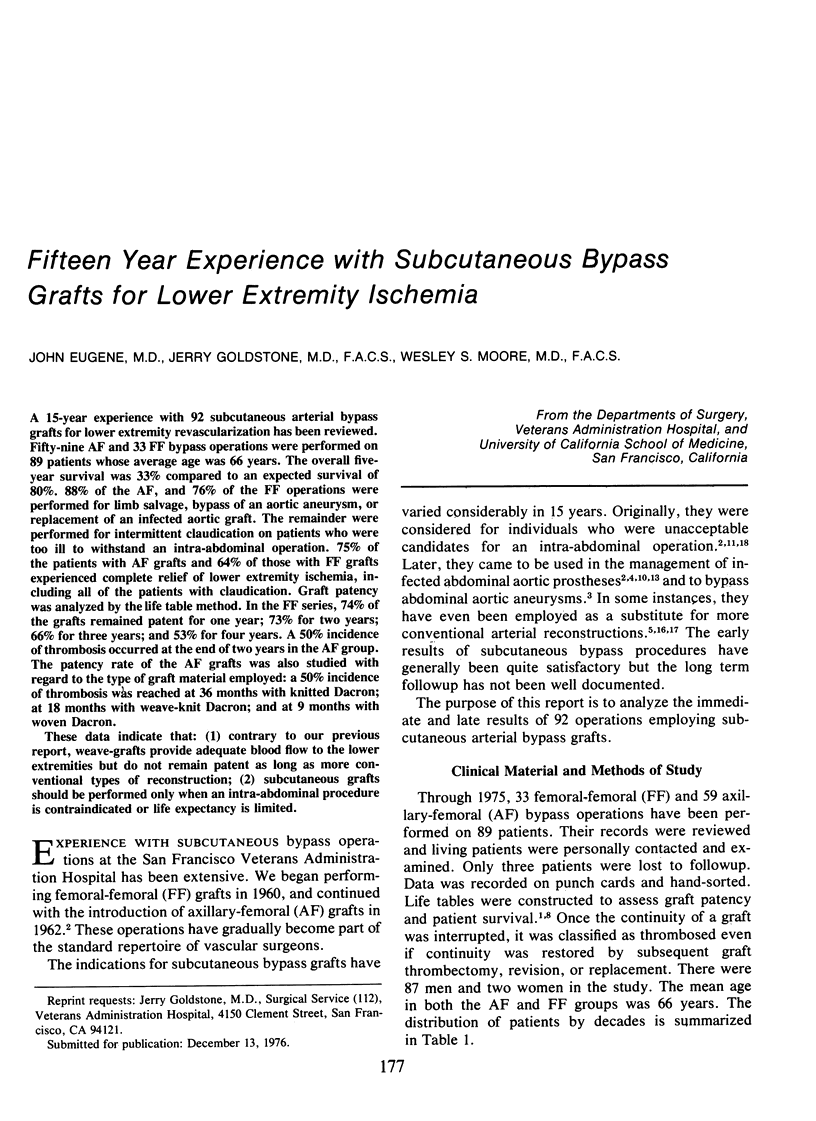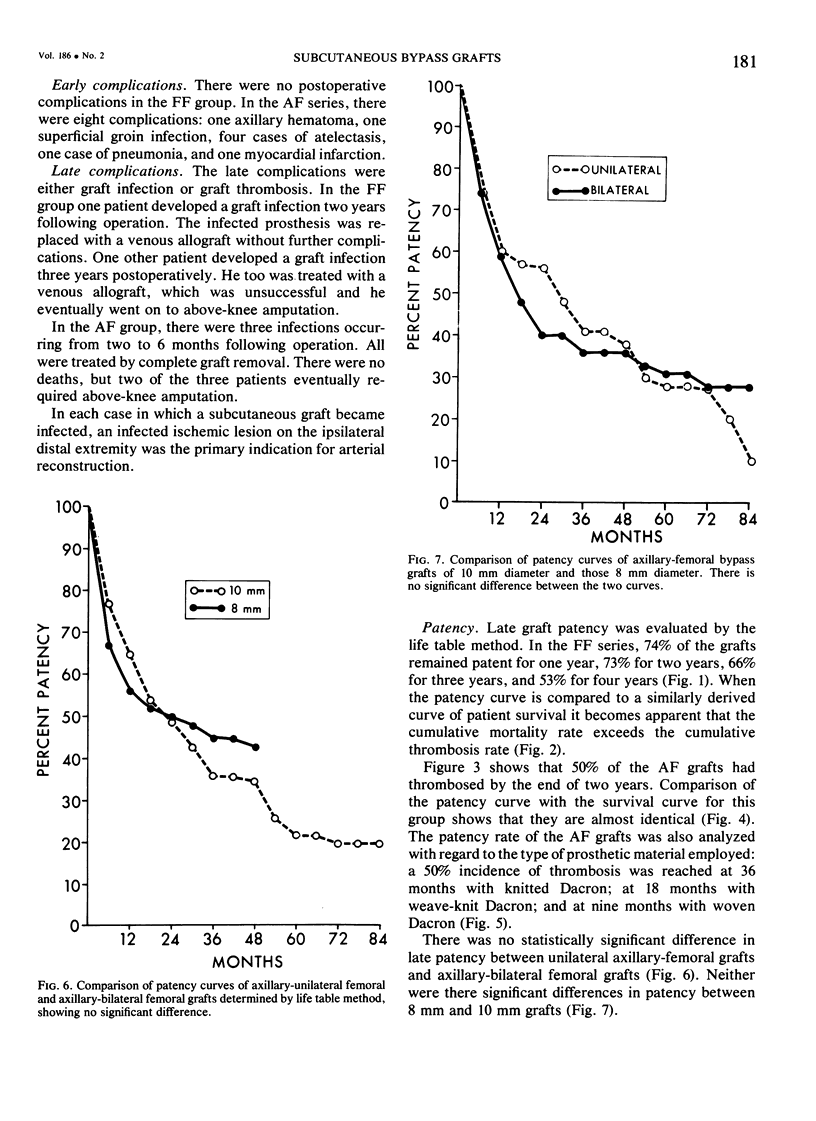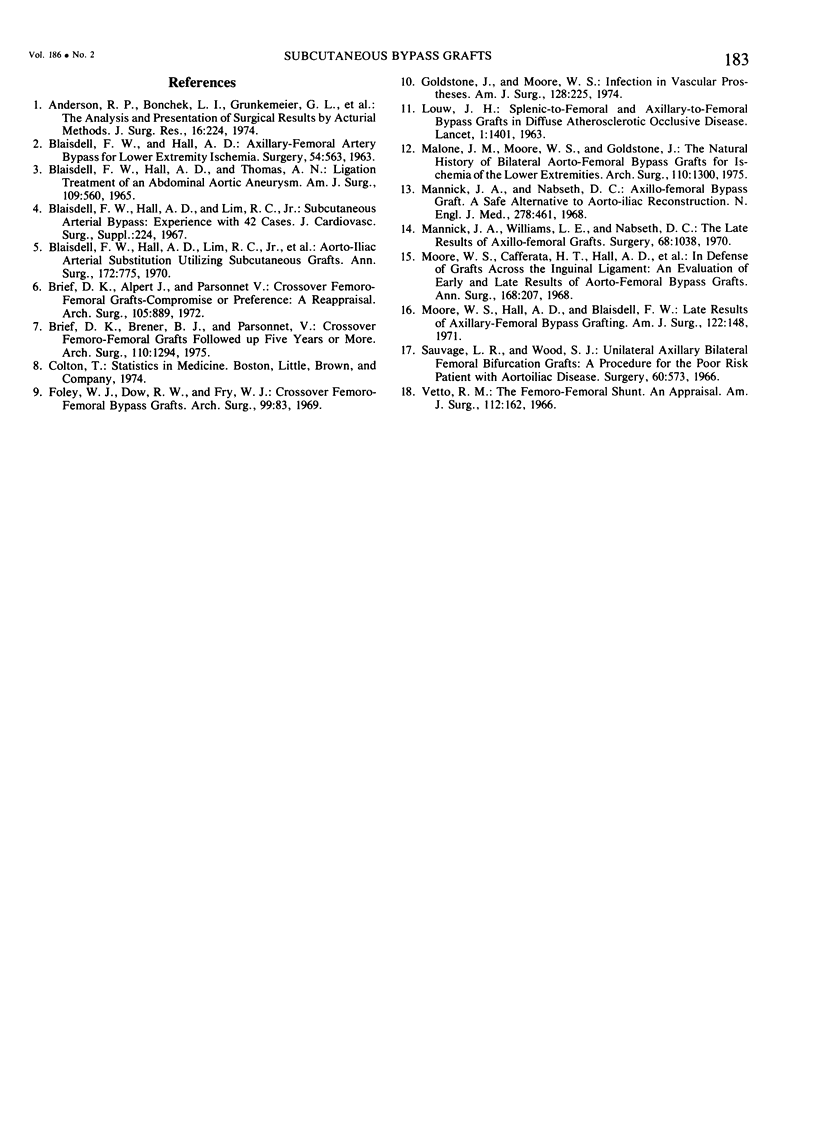Abstract
A 15-year experience with 92 subcutaneous arterial bypass grafts for lower extremity revascularization has been reviewed. Fifty-nine AF and 33 FF bypass operations were performed on 89 patients whose average age was 66 years. The overall five-year survival was 33% compared to an expected survival of 80%. 88% of the AF, and 76% of the FF operations were performed for limb salvage, bypass of an aortic aneurysm, or replacement of an infected aortic graft. The remainder were performed for intermittent claudication on patients who were too ill to withstand an intra-abdominal operation. 75% of the patients with AF grafts and 64% of those with FF grafts experienced complete relief of lower extremity ischemia, including all of the patients with claudication. Graft patency was analyzed by the life table method. In the FF series, 74% of the grafts remained patent for one year; 73% for two years; 66% for three years; and 53% for four years. A 50% incidence of thrombosis occurred at the end of two years in the AF group. The patency rate of the AF grafts was also studied with regard to the type of graft material employed: a 50% incidence of thrombosis was reached at 36 months with knitted Dacron; at 18 months with weave-knit Dacron; and at 9 months with woven Dacron.
These data indicate that: (1) contrary to our previous report, weave-grafts provide adequate blood flow to the lower extremities but do not remain patent as long as more conventional types of reconstruction; (2) subcutaneous grafts should be performed only when an intra-abdominal procedure is contraindicated or life expectancy is limited.
Full text
PDF






Selected References
These references are in PubMed. This may not be the complete list of references from this article.
- Anderson R. P., Bonchek L. I., Grunkemeier G. L., Lambert L. E., Starr A. The analysis and presentation of surgical results by actuarial methods. J Surg Res. 1974 Mar;16(3):224–230. doi: 10.1016/0022-4804(74)90035-3. [DOI] [PubMed] [Google Scholar]
- BLAISDELL F. W., HALL A. D. AXILLARY-FEMORAL ARTERY BYPASS FOR LOWER EXTREMITY ISCHEMIA. Surgery. 1963 Oct;54:563–568. [PubMed] [Google Scholar]
- BLAISDELL F. W., HALL A. D., THOMAS A. N. LIGATION TREATMENT OF AN ABDOMINAL AORTIC ANEURYSM. Am J Surg. 1965 May;109:560–565. doi: 10.1016/s0002-9610(65)80004-6. [DOI] [PubMed] [Google Scholar]
- Blaisdell F. W., Hall A. D., Lim R. C., Jr, Moore W. C. Aorto-iliac arterial substitution utilizing subcutaneous grafts. Ann Surg. 1970 Nov;172(5):775–780. doi: 10.1097/00000658-197011000-00001. [DOI] [PMC free article] [PubMed] [Google Scholar]
- Brief D. K., Alpert J., Parsonnet V. Crossover femoro-femoral grafts. Compromise or preference: a reappraisal. Arch Surg. 1972 Dec;105(6):889–894. doi: 10.1001/archsurg.1972.04180120070013. [DOI] [PubMed] [Google Scholar]
- Brief D. K., Brener B. J., Alpert J., Parsonnet V. Crossover femorofemoral grafts followed up five years or more. An analysis. Arch Surg. 1975 Nov;110(11):1294–1299. doi: 10.1001/archsurg.1975.01360170034004. [DOI] [PubMed] [Google Scholar]
- Foley W. J., Dow R. W., Fry W. J. Crossover femoro-femoral bypass grafts. Arch Surg. 1969 Jul;99(1):83–87. doi: 10.1001/archsurg.1969.01340130085016. [DOI] [PubMed] [Google Scholar]
- Goldstone J., Moore W. S. Infection in vascular prostheses. Clinical manifestations and surgical management. Am J Surg. 1974 Aug;128(2):225–233. doi: 10.1016/0002-9610(74)90097-x. [DOI] [PubMed] [Google Scholar]
- Malone J. M., Moore W. S., Goldstone J. The natural history of bilateral aortofemoral bypass grafts for ischemia of the lower extremities. Arch Surg. 1975 Nov;110(11):1300–1306. doi: 10.1001/archsurg.1975.01360170040005. [DOI] [PubMed] [Google Scholar]
- Mannick J. A., Nabseth D. C. Axillofemoral bypass graft. A safe alternative to aortoiliac reconstruction. N Engl J Med. 1968 Feb 29;278(9):461–466. doi: 10.1056/NEJM196802292780901. [DOI] [PubMed] [Google Scholar]
- Mannick J. A., Williams L. E., Nabseth D. C. The late results of axillofemoral grafts. Surgery. 1970 Dec;68(6):1038–1043. [PubMed] [Google Scholar]
- Moore W. S., Cafferata H. T., Hall A. D., Blaisdell F. W. In defense of grafts across the inguinal ligament. An evaluation of early and late results of aorto-femoral bypass grafts. Ann Surg. 1968 Aug;168(2):207–214. doi: 10.1097/00000658-196808000-00005. [DOI] [PMC free article] [PubMed] [Google Scholar]
- Moore W. S., Hall A. D., Blaisdell F. W. Late results of axillary-femoral bypass grafting. Am J Surg. 1971 Aug;122(2):148–154. doi: 10.1016/0002-9610(71)90309-6. [DOI] [PubMed] [Google Scholar]
- Sauvage L. R., Wood S. J. Unilateral axillary bilateral femoral bifurcation graft: a procedure for the poor risk patient with aortoiliac disease. Surgery. 1966 Sep;60(3):573–577. [PubMed] [Google Scholar]
- Vetto R. M. The femorofemoral shunt. An appraisal. Am J Surg. 1966 Aug;112(2):162–165. doi: 10.1016/0002-9610(66)90004-3. [DOI] [PubMed] [Google Scholar]


